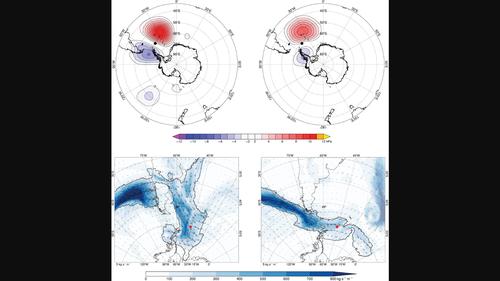Extreme warm events in the South Orkney Islands, Southern Ocean: Compounding influence of atmospheric rivers and föhn conditions
IF 2.9
3区 地球科学
Q2 METEOROLOGY & ATMOSPHERIC SCIENCES
引用次数: 1
Abstract
Abstract Extreme warm events in the South Orkney Islands (SOIs) are investigated using synoptic observations from Signy and Orcadas stations for 1947–1994 and 1956–2019 respectively. Defining the extremes as temperatures exceeding the 95th percentile of the temperature distribution, we reveal the characteristics and associated drivers of the warm events, especially the top 10 events in both summer and winter. At both stations, extreme warm events often involve a combined effect of atmospheric rivers (ARs) and localised föhn warming, with distinct characteristics due to the station locations relative to Coronation Island, the largest and highest island of the SOIs. For example, warm events at Signy are warmer (by an average of around 3°C) than the corresponding concurrent temperatures at Orcadas. The number of warm events per year has significantly increased over the record periods at both stations, which could potentially impact ecosystems by increasing melting of snow and ice. Extreme warm events at Signy are dominated by föhn warming in combination with ARs originating from the Southern Atlantic Ocean, where warm, moisture‐rich air is rapidly advected towards the islands by enhanced northerly winds. By contrast, the Orcadas warm extremes involve both warm‐air advection and föhn warming associated with enhanced northwesterlies/westerlies with ARs originating in the Pacific Ocean that travel across the Drake Passage. Simulation of one of the top 10 warm events for Signy station using a 1‐km grid spacing configuration of the atmosphere‐only UK Met Office Unified Model is used to disentangle the role of local versus large‐scale forcing. We find that the majority of the warming can be attributed to föhn effects for the case study. These results demonstrate the complexity of Antarctic temperature extremes.

南大洋南奥克尼群岛的极端温暖事件:大气河流和föhn条件的综合影响
利用Signy和Orcadas站1947-1994年和1956-2019年的天气观测资料,对南奥克尼群岛(SOIs)的极端温暖事件进行了研究。我们将极端温度定义为温度分布超过95百分位,揭示了温暖事件的特征和相关驱动因素,特别是夏季和冬季的前10个事件。在这两个台站,极端温暖事件通常涉及大气河流(ARs)和局地föhn变暖的综合影响,由于台站位置相对于SOIs中最大和最高的岛屿Coronation岛,因此具有明显的特征。例如,Signy的温暖事件比Orcadas的相应同期温度要高(平均约3°C)。在这两个气象站,每年温暖事件的数量都比有记录的时期显著增加,这可能会通过增加冰雪融化来潜在地影响生态系统。Signy的极端温暖事件主要是föhn变暖与源自南大西洋的ar相结合,在那里,温暖、富含水分的空气被增强的北风迅速平流到岛屿。相比之下,Orcadas极端温暖包括暖空气平流和föhn变暖,这与源自太平洋的西北/西风带增强有关,这些西风带穿过德雷克海峡。使用仅限大气的英国气象局统一模式的1公里网格间距配置,模拟Signy站的前10大暖事件之一,以区分局部强迫和大尺度强迫的作用。我们发现,大多数变暖可归因于föhn对案例研究的影响。这些结果显示了南极极端温度的复杂性。
本文章由计算机程序翻译,如有差异,请以英文原文为准。
求助全文
约1分钟内获得全文
求助全文
来源期刊
CiteScore
16.80
自引率
4.50%
发文量
163
审稿时长
3-8 weeks
期刊介绍:
The Quarterly Journal of the Royal Meteorological Society is a journal published by the Royal Meteorological Society. It aims to communicate and document new research in the atmospheric sciences and related fields. The journal is considered one of the leading publications in meteorology worldwide. It accepts articles, comprehensive review articles, and comments on published papers. It is published eight times a year, with additional special issues.
The Quarterly Journal has a wide readership of scientists in the atmospheric and related fields. It is indexed and abstracted in various databases, including Advanced Polymers Abstracts, Agricultural Engineering Abstracts, CAB Abstracts, CABDirect, COMPENDEX, CSA Civil Engineering Abstracts, Earthquake Engineering Abstracts, Engineered Materials Abstracts, Science Citation Index, SCOPUS, Web of Science, and more.

 求助内容:
求助内容: 应助结果提醒方式:
应助结果提醒方式:


